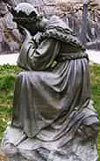Progressivism in the Church
Church Revolution in Pictures
Photo of the Week
/521-Mono01.jpg)
Pope Francis receives Monophysite award
As it is known, Monophysitism or Monophysism is an old heresy that denies Our Lord Jesus Christ has two natures, a divine nature hypostatically united to a human nature. Their followers profess that Christ has only one nature, the divine nature, which supposedly entirely absorbed the human nature. From this comes the name of their heresy: mono = one, single; physis = nature.
Pope Honorius, who adhered to a formula containing the errors of Monoenergism, a variant of Monophysitism, was declared a heretic by Pope Leo II and the Third Council of Constantinople. He became the classical case of a heretic Pope, which sets the precedent for the study of the present day crisis where we see Progressivism devastating the Papacy.
Today the heresy of Monophysitism exists principally in Egypt among the Copts. Their followers calling themselves "orthodox copts," although the name orthodox is an evident misnomer since they profess a clear heresy.
In the picture above, you see Pope Francis, on May 10, 2013, holding a picture of the Risen Christ along with two Monophysite hierarchs, as if the three were in agreement that He has only one nature. Below, first row, Tawadros II, the "pope" of that heretical sect offering a chain with an icon medallion to Francis, an award only given to those in communion of doctrine with the Monophysites. Third row, Francis euphorically thanks the heretic for his bequest with a warm two-handed clasp.
Fourth row, Francis and Tawadros in the papal library at the Vatican, seated in equal chairs, as if the Catholic Pope and the heretic had the same rank. Fifth row, Francis delivers a speech to the Monophysitist delegation in a newly decorated carnival-style room in the Vatican. He proposed that every May 10, the Monophysitist "pope" and the Progressivist Pope should meet at the Vatican... Sixth row, he humbly receives the "blessing" Tawadros gives to those present at the meeting.
Given these manifestations of communion in the "same faith," it seems impossible to avoid this question: If Pope Honorius was rightly considered a heretic by Pope Leo II, the Third Council of Constantinople and several other Popes for professing errors linked to Monophysitism, why should the conciliar Popes - who do more than that - not be included in the same qualification?
/521-Mono02.jpg)
/521-Mono03.jpg)












